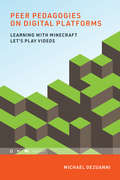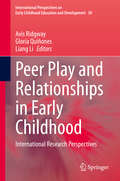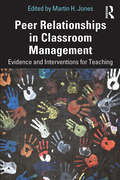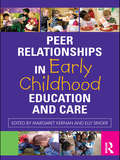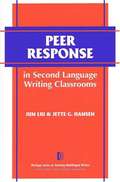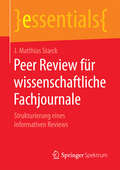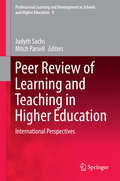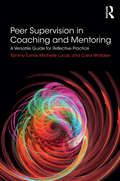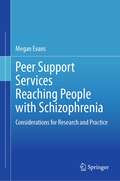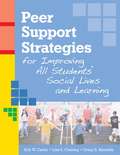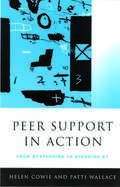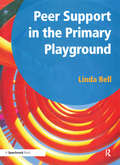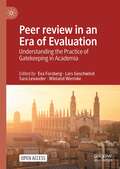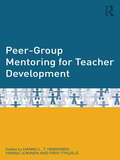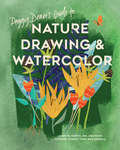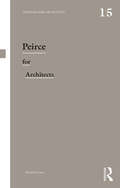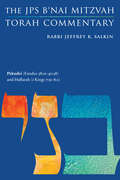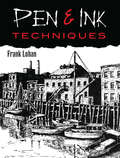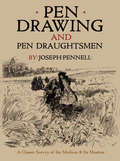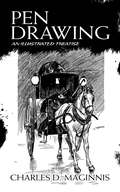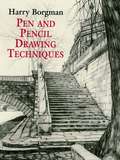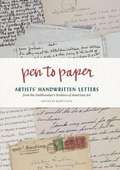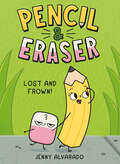- Table View
- List View
Peer Pedagogies on Digital Platforms: Learning with Minecraft Let's Play Videos (Learning in Large-Scale Environments)
by Michael DezuanniHow a popular entertainment genre on YouTube--Let's Play videos created by Minecraft players--offers opportunities for children to learn from their peers.Every day millions of children around the world watch video gameplay on YouTube in the form of a popular entertainment genre known as Let's Play videos. These videos, which present a player's gameplay and commentary, offer children opportunities for interaction and learning not available in traditional television viewing or solo video gameplay. In this book, Michael Dezuanni examines why Let's Play videos are so appealing to children, looking in particular at videos of Minecraft gameplay. He finds that a significant aspect of the popularity of these videos is the opportunity for knowledge and skill exchange.
Peer Play and Relationships in Early Childhood: International Research Perspectives (International Perspectives on Early Childhood Education and Development #30)
by Avis Ridgway Gloria Quiñones Liang LiThis book offers a rich collection of international research narratives that reveal the qualities and value of peer play. It presents new understandings of peer play and relationships in chapters drawn from richly varied contexts that involve sibling play, collaborative peer play, and joint play with adults. The book explores social strategies such as cooperation, negotiation, playing with rules, expressing empathy, and sharing imaginary emotional peer play experiences. Its reconceptualization of peer play and relationships promotes new thinking on children's development in contemporary worlds. It shows how new knowledge generated about young children's play with peers illuminates how they learn and develop within and across communities, families, and educational settings in diverse cultural contexts. The book addresses issues that are relevant for parents, early years' professionals and academics, including the role of play in learning at school, the role of adults in self-initiated play, and the long-term impact of early friendships. The book makes clear how recent cultural differences involve digital, engineering and imaginary peer play. The book follows a clear line of argument highlighting the importance of play-based learning and stress the importance of further knowledge of children's interaction in their context. This book aims to highlight the narration of peer play, mostly leaning on a sociocultural theoretical perspective, where many chapters have a cultural-historical theoretical frame and highlight children's social situation of development. Polly Björk-Willén, Linköping University, Sweden
Peer Relationships in Classroom Management: Evidence and Interventions for Teaching
by Martin H. JonesPeer Relationships in Classroom Management offers pragmatic, empirically validated guidance to teachers in training on issues pertaining to students’ interpersonal relationships. Concepts such as bullying, popularity, and online friendships are ubiquitous in today’s schools, but what kinds of scientific and pedagogical knowledge can support teachers navigating students’ complex lives? Using real-world examples and case studies, this book helps preservice educators to enhance their knowledge of classroom management by focusing on the interpersonal relationships in their schools. Each chapter includes an accessible approach to understanding the social motives in student’s peer interactions inside school, and how to best intervene when these social interactions become detrimental to learning or cause negative interpersonal interactions.
Peer Relationships in Early Childhood Education and Care
by Margaret KernanPeer Relationships in Early Childhood Education and Care brings together fresh perspectives and research about young children’s relationships. It examines children’s rights and well-being against a backdrop of increased social movement and migration, changing family structures and work practices, and the growing prevalence of education and care services for young children. With contributors from diverse cultural, geographical and disciplinary backgrounds, this edited collection shows how educators support children’s peer relationships and use these as a basis for enhancing social and cognitive development. Themes discussed include: conflicts and negotiations friendships and play group phenomena independence and interdependence identity and belonging peer relations and children with disabilities attuning adults to young children’s relationships. This book will be highly relevant for academics, researchers and students concerned with early childhood care and education, especially those interested in relating these issues on a global scale.
Peer Response in Second Language Writing Classrooms
by Liu Hansen Jun Jette G.Peer response in which students work together to provide feedback on one another's writing in both written and oral formats through active engagement with each other's progress over multiple drafts, has been discussed in L2 writing literature since the early 1980s. While peer response activities have now become a common feature of L2 writing instruction, much of the research in peer response studies presents conflicting data. There is a need for a comprehensive survey of it in an effort to help teachers sort out what may or may not be useful to them in the classroom. Peer Response in Second Language Writing Classrooms was written to fill that void. Peer Response in Second Language Writing Classrooms will provide teachers with practical guidelines for making peer response effective in the classroom and will offer a theoretical grounding on the purposes and importance of peer review, or feedback, as it relates to current writing instruction pedagogy.
Peer Review für wissenschaftliche Fachjournale: Strukturierung eines informativen Reviews (essentials)
by J. Matthias StarckJ. Matthias Starck führt den Leser in diesem essential durch alle Schritte des Schreibens eines Peer Reviews für eine wissenschaftliche Zeitschrift. Es baut auf einer prägnanten Analyse auf, wie Wissenschaft funktioniert, wie sie kommuniziert und wie sie veröffentlicht wird. Der Autor diskutiert verschiedene Peer-Review-Verfahren und deren mögliche Alternativen, ethische Leitlinien ebenso wie die ,dunklen Seitenʻ des wissenschaftlichen Publizierens. Damit hilft dieses essential dem Leser, im bestehenden System erfolgreich zu arbeiten sowie zu seiner weiteren Entwicklung und Verbesserung beizutragen.
Peer Review of Learning and Teaching in Higher Education
by Judyth Sachs Mitch ParsellIncorporating both theoretical and practical perspectives, this volume of papers explores varied aspects of peer review of teaching in higher education. The section on theory features contributions from academics based in Europe, North America and Australia. It provides a number of models demonstrating ways in which collegial peer commentary can enhance the quality of learning and teaching. The chapters examine in detail the importance of communication and leadership, and deploy evidence from one-on-one interviews that evince the value of considering collegiality, emotions, attitudes, and spaces in peer review. The analysis shows how these factors are central to the ways in which lecturers and teachers communicate with each other to create constructive opportunities for learning. The chapters on practical considerations detail the peer review process and include case studies from institutions in Africa, Europe, North America and Australia, which focus on different areas of the topic, including peer review as a quality assurance mechanism, peer review in distance education, peer review in foundation courses, and peer review embedded within a department and across a university. The book ends with an international perspective on the role of peer review in ensuring a holistic approach to quality enhancement in learning and teaching.
Peer Supervision in Coaching and Mentoring: A Versatile Guide for Reflective Practice
by Tammy Turner Carol Whitaker Michelle LucasSupervision is increasingly required for a coach’s and a mentor's professional development, and engaging in reflective practice with peers can be a valuable way of meeting these needs. Peer supervision brings unique challenges though, including the possibility of collusion or stagnating at a shared developmental level. This book is written by practicing professional supervisors who engage in peer supervision themselves and train communities of coaches and mentors. It guides practitioners to develop and integrate their range of individual and group reflective practice activities alongside professional supervision. It draws upon essential theory and methodology, explores challenges and ethical dilemmas faced within peer supervision, and provides concrete guidance, useful techniques and helpful templates. This practical guide will be vital reading for individual coaching and mentoring practitioners and peer learning groups including within communities, universities and/or training programs. It will also support professional supervisors and organizations developing coaching cultures.
Peer Support Services Reaching People with Schizophrenia: Considerations for Research and Practice
by Megan EvansMany mental health providers are seeking guidance in designing and improving peer support programs for people with mental illnesses. However, the evidence base in this area is limited by lack of consensus on the core components of peer support. This research provides a comprehensive, nuanced view of peer support reaching people with schizophrenia. Results of a realist review of 355 sources and interviews with experts in the field are presented. Realist review is an approach to evidence synthesis that asks, ‘What works, for whom, and in what circumstances?’ Results include a typology of key functions of peer support (e.g., being there, linkage to clinical care and community resources, systems advocacy, ongoing support), documented benefits (e.g., decreased acute care utilization, increased recovery), and implementation recommendations (e.g., critical mass of peer workers, supportive infrastructure, an organizational recovery orientation). The book is intended for program planners, managers, and researchers.
Peer Support Strategies For Improving All Students' Social Lives And Learning
by Erik W. Carter Craig H. Kennedy Lisa S. CushingPeer supports really work: they're a great, efficient way to help all students learn, make the most of teacher/ paraprofessional time, and increase the achievement level of challenging students. This is the concise, practical guide every middle and high school needs to implement peer support strategies--including cooperative learning and peer tutoring--to benefit students with moderate to severe disabilities and their peers. With this reader-friendly, step-by-step planning guide from the foremost authorities on peer supports, educators, paraprofessionals, and other school staff will discover how peer supports are a "two-way street," boosting the academic outcomes, social skills, and self-esteem of students with disabilities and the peers who support them determine which students might benefit most from peer supports recruit and match the students most likely to form mutually beneficial relationships develop effective support plans that promote access to the general curriculum work peer supports into IEP goals to meet state and national academic standards give students the training and guidance they need to approach their support roles with confidence and enthusiasm clarify the responsibilities of everyone involved in a peer support system: students, general and special educators, paraprofessionals and other school staff provide peers with constructive ongoing feedback extend peer supports to school activities and extracurricular events evaluate the social and academic impact of peer support arrangements A complete, start-to-finish guide to peer supports, this book is packed with photocopiable planning, implementation, and evaluation tools; evidence-based strategies; and vignettes that illustrate successful peer supports. With this must-have book on one of the hottest topics in inclusive education, educators and paraprofessionals will create schools where all students--with and without disabilities--help each other reach their academic goals, make new friends, and live full and meaningful lives.
Peer Support in Action: From Bystanding to Standing By
by Helen Cowie Patti Wallace`It would be of use to adults and teachers who are starting to research peer support and the logistics of adopting such a scheme in their school. It would also be of use to saff who are currently operating a peer support scheme. I personally will use this book and keep a copy in the counselling service library, recommending it to counsellors/trainers and teachers interested or already facilitating peer support in their schools′ - British Journal of Guidance and Counselling `It is to read, comprehensive in its structure and advice and through examples of first-hand experiences, makes the reader feel enthusiastic about trying out different ideas…. An excellent handbook for the manager of a peer support system for any organization′ - Anne Woodhouse, Clinical Child Psychology and Psychiatry Peer support systems are increasingly being used in schools and other youth settings to tackle problems such as bullying, rejection, social exclusion, sexual identity, self-esteem and loneliness. Peer Support in Action is a practical guide which gives adults who work with children and young people the knowledge, understanding and practical tools to provide effective and appropriate systems of peer support. Helen Cowie and Patti Wallace combine insights drawn from practice with up-to-date research findings, to give a sound basis for peer-based interventions. They encourage readers to build on the potential for offering help which many young people have and give practical guidance on how to train, guide and supervise them in supporting their peers. Peer Support in Action is for teachers, educational psychologists, social workers, education welfare officers, counsellors and counselling psychologists and all professionals involved in the pastoral care and guidance of children and young people.
Peer Support in the Primary Playground
by Linda BellThis book is an essential resource to develop playground relationships. Increasingly schools are working very closely with their children, helping them to develop the skills needed to take charge of their own actions and encourage responsible attitudes towards others in the school. The programme for children outlined in this book, 'Playground Champions', is a primary playground peer support initiative which: trains older children to support their peers in solving issues within the playground by focusing on rebuilding relationships rather than apportioning blame; encourages children to see the viewpoint of others and to create their own mutually agreeable solutions; and, helps to establish emotional health and well-being, safety and happiness. The programme is structured, easy to follow and can be used by teachers and teaching assistants within the school. These printable training materials and resources are comprehensive and can be readily adapted to suit the needs of individual children and schools. The programme fits into the current national initiatives such as Every Child Matters, Social and Emotional Aspects of Learning (SEAL), Citizenship and National Healthy Schools and demonstrates good practice for the annual school self-evaluation form (SEF) and Ofsted. It can also add to the evidence required for the school's disability equality scheme showing that they are committed to disability equality and eliminating bullying and harassment. When properly implemented it will help to develop confidence and improve self-esteem in pupils as well as improving behaviour and reducing stress, leading to a happier and healthier school environment. It is suitable for age: 4-11.
Peer review in an Era of Evaluation: Understanding the Practice of Gatekeeping in Academia
by Lars Geschwind Wieland Wermke Eva Forsberg Sara LevanderThis open access volume explores peer review in the scientific community and academia. While peer review is as old as modern science itself, recent changes in the evaluation culture of higher education systems have increased the use of peer review, and its purposes, forms and functions have become more diversified. This book put together a comprehensive set of conceptual and empirical contributions on various peer review practices with relevance for the scientific community and higher education institutions worldwide. Consisting of three parts, the editors and contributors examine the history, problems and developments of peer review, as well as the specificities of various peer review practices. In doing so, this book gives an overview on and examine peer review , and asks how it can move forward.This is an open access book.
Peer-Group Mentoring for Teacher Development
by Päivi Tynjälä Hannu L.T. Heikkinen Hannu JokinenSupporting new teachers is a common challenge globally and the European Commission has recently emphasised the need to promote a lifelong continuum of teachers professional development by building bridges between pre-service and in-service teacher education.Peer-Group Mentoring for Teacher Development introduces and contextualises for an internati
Peer-assisted Learning: A Practical Guide For Teachers
by Keith Topping Stewart EhlyPeer Assisted Learning (PAL) involves children in school consciously assisting others to learn, and in so doing learning more effectively themselves. It encompasses peer tutoring, peer modeling, peer education, peer counseling, peer monitoring, and peer assessment, which are differentiated from other more general "co-operative learning" methods. PAL is not diluted or surrogate "teaching"; it complements and supplements (but never replaces) professional teaching--capitalizing on the unique qualities and richness of peer interaction and helping students become empowered democratically to take more responsibility for their own learning. In this book, PAL is presented as a set of dynamic, robust, effective, and flexible approaches to teaching and learning, which can be used in a range of different settings. The chapters provide descriptions of good practice blended with research findings on effectiveness. They describe procedures that can be applied to all areas of the school curriculum, and can be used with learners of all levels of ability, including gifted students, students with disabilities, and second-language learners. Among the distinguished contributors, many are from North America, while others are from Europe and Australia. The applicability of the methods they present is worldwide. Peer-Assisted Learning is designed to be accessible and useful to teachers and to those who employ, train, support, consult with, and evaluate them. Many chapters will be helpful to teachers aiming to replicate in their own school environments the cost-effective procedures described. A practical resources guide is included. This volume will also be of interest to faculty and researchers in the fields of education and psychology, to community educators who want to learn about the implications of Peer Assisted Learning beyond school contexts, and to employers and others involved in post-school training.
Peggy Dean's Guide to Nature Drawing and Watercolor: Learn to Sketch, Ink, and Paint Flowers, Plants, Trees, and Animals
by Peggy DeanThis fun and easy-to-use nature drawing and watercolor guide is perfect for anyone inspired by nature to draw, doodle, ink, and paint colorful flora and fauna. Artist, author, and popular art instructor Peggy Dean presents this nature drawing guide that teaches you how to master drawing and watercolor techniques from sketching and shading to washes and blending. With Peggy's easy and energetic lessons, absolutely anyone--regardless of ability--can learn to draw the natural world. Beginning with delicate cherry blossoms, wildflowers, and lacy ferns, lessons build to composing stunning bouquets of flowers and majestic landscapes. You'll also discover how to draw animals such as colorful fish and birds in flight, as well as mammals like stoic camels and the mighty polar bear. Through the lessons on technique combined with clear, detailed instructions, you'll gain the expertise and confidence that will allow you to quickly build your skills, discover your own personal style, and achieve beautiful botanical and animal illustrations.
Peirce for Architects (Thinkers for Architects)
by Richard CoyneIdeas gain legitimacy as they are put to some practical use. A study of Charles Sanders Peirce (1839-1914) supports this pragmatism as a way of thinking about truth and meaning. Architecture has a strong pragmatic strand, not least as we think of building users, architecture as a practice, the practical demands of building, and utility. After all, Vitruvius placed firmness and delight in the company of utilitas amongst his demands on architecture. Peirce (pronounced 'purse') was a logician, and so many of his ideas are couched in terms of formal propositions and their limitations. His work appeals therefore to many architects grappling with the digital age, and references to his work cropped up in the Design Methods Movement that developed and grew from the 1950s. That movement sought to systematise the design process, contributing to the idea of the RIBA Plan of Work, computer-aided design, and various controversies about rendering the design process transparent and open to scrutiny. Peirce’s commitment to logic led him to investigate the basic elements of logical statements, notably the element of the sign. His best-known contribution to design revolves around his intricate theory of semiotics, the science of signs. The study of semiotics divided around the 1980s between advocates of Peirce’s semiotics, and the broader, more politically charged field of structuralism. The latter has held sway in architectural discourse since the 1980s. Why this happened and what we gain by reviving a Peircean semiotics is the task of this book.
Pekudei: The JPS B'nai Mitzvah Torah Commentary (JPS Study Bible)
by Rabbi Jeffrey K. SalkinPekudei (Exodus 38:21-40:38) and Haftarah (1 Kings 7:40-50): The JPS B’nai Mitzvah Torah Commentary shows teens in their own language how Torah addresses the issues in their world. The conversational tone is inviting and dignified, concise and substantial, direct and informative. Each pamphlet includes a general introduction, two model divrei Torah on the weekly Torah portion, and one model davar Torah on the weekly Haftarah portion. Jewish learning—for young people and adults—will never be the same. The complete set of weekly portions is available in Rabbi Jeffrey K. Salkin’s book The JPS B’nai Mitzvah Torah Commentary (JPS, 2017).
Pen & Ink Drawing (Dover Art Instruction)
by Frank J. LohanAn inspiring sourcebook for all skill levels, this guide helps artists discover a wide variety of subjects and ideas for their next sketch. More than 140 of the author's own drawings include partially finished details that illustrate how to achieve the desired visual effects. Stimulating topics include nostalgic scenes, old engravings, atmospheric effects, photographs, landscapes, and life itself.
Pen & Ink Techniques
by Frank J. LohanThis reader-friendly guide allows artists and would-be artists at all levels of achievement to experience the satisfaction of drawing with pen and ink techniques. Richly illustrated and containing dozens of simple exercises, it covers everything from the basic tools and materials to the production of advanced effects.A seasoned instructor, author Frank Lohan presents dozens of exercises for beginning, intermediate, and advanced artists. His topics range from the creation of hatching, tones, and stippling to dealing with the problems that can arise when adding texture, light, and shade. An extensive reference section features examples of landscapes, trees and foliage, flowers, faces, animals, and a wealth of other subjects. Helpful suggestions include tips for copying, reducing, and enlarging sketches; instructions for easy matting; and guidelines for reproducing sketches on greeting cards and notepaper.
Pen Drawing and Pen Draughtsmen: A Classic Survey of the Medium and Its Masters (Dover Fine Art, History of Art)
by Joseph PennellIn this comprehensive study of the art of drawing with a pen, artist and author Joseph Pennell highlights his opinionated "technical suggestions" with more than 400 illustrations by 250 famous artists, including Titian, Dürer, Rembrandt, Rodin, Manet, Renoir, Beardsley, Pyle, Hiroshige, van Gogh, Rackham, and other masters from around the globe. Each of the high-quality reproductions is accompanied by a critique of its style and execution and occasional comparisons to the artist's other works and those of contemporaries. Featured images range from landscapes by Titian, Rembrandt, and Corot to figure studies by Dürer, Goya, and Rodin and portraits by Manet and Matisse. The tremendous variety of subjects extends to street scenes by Toulouse Lautrec and van Gogh, episodes from literature envisioned by Rossetti, Burne-Jones, and Millais, and decorations by Crane and Morris. A visual treasure trove and valuable reference, this volume will serve as an enduring source of instruction and inspiration for artists of all skill levels.
Pen Drawing: An Illustrated Treatise
by Charles D. MaginnisStyle, materials, techniques, and values are the focus of this richly illustrated guide to pen drawing. In addition to proposing solutions for practical problems, the book offers advice on architectural and decorative drawing. More than 70 drawings by assorted artists range from tranquil churchyards and bustling city streets to striking posters. Many of the images are derived from The Century Magazine, Harper's Magazine, The Architectural Review, and other illustrated periodicals of the early twentieth century.Irish-American architect Charles D. Maginnis (1867-1955), a co-founder of the firm Maginnis & Walsh, was active in the design of ecclesiastical and campus buildings across the United States. He also served as President of the American Institute of Architects from 1937-39. Maginnis' practical guide to pen drawing features several of his own illustrations, created expressly for this instructive volume.
Pen and Pencil Drawing Techniques (Dover Art Instruction)
by Harry BorgmanCompact but comprehensive, this manual contains the best information available on pencil and ink techniques. Written and beautifully illustrated by an acclaimed artist and advertising illustrator, it's the perfect companion for artists seeking a guide to the variety of techniques and media for rendering their ideas on paper.Pencil drawing and ink drawing receive separate treatments; both sections stress materials and tools -- including graphite pencils, charcoal and pastel pencils, wax pencils, pens, brushes, marking pens, scratching tools, and more. They also explore different methods of handling strokes and lines, techniques for stabling and conveying tones and shadows, and technical tips. The 28 step-by-step demonstrations -- many of them exquisitely illustrated in full color -- range from techniques of fine penwork and cross-hatching to drawing with colored inks and colored markers. In addition, a series of multipart exercises will prove extraordinarily useful to the student. The profusion of skillful illustrations throughout the book, over 540 in all, constitute a treasure in themselves, covering a great diversity of subjects -- from portraits and still lifes to landscapes and cityscapes worldwide.
Pen to Paper: Artists' Handwritten Letters from the Smithsonian's Archives of American Art
by Mary SavigEven in this age of emails, texts, and tweets, there is an ongoing fascination with the simple act of putting pen to paper. Associations such as the International Association of Master Penmen and the Society for Italic Handwriting keep the traditions of calligraphy and penmanship alive, hand-writing typefaces continue to sell, and hand-drawn display type and packaging of all sorts enjoy a renaissance.Pen to Paper, a collection of letters by artists from the Smithsonian's Archives of American Art, reveals how letter writing can be an artistic act, just as an artist puts pen to paper to craft a line in a drawing. Brief essays explore what can be learned from the handwriting of celebrated artists such as Mary Cassatt, Frederic Church, Howard Finster, Winslow Homer, Ray Johnson, Rockwell Kent, Georgia O'Keeffe, Claes Oldenburg, Maxfield Parrish, Eero Saarinen, Saul Steinberg, and many others. Each letter is accompanied by an archival image of the artist or a related artwork, with a full transcription. Pen to Paper provides a fresh way to think about artists and their creative work and is sure to inspire your next handwritten note or letter.
Pencil & Eraser: An Early Reader Graphic Novel (Pencil & Eraser)
by Jenny AlvaradoFans of NARWHAL AND JELLY as well as PIZZA AND TACO, prepare to meet your new favorite duo: a pair of best friend school supplies! In the next adventure of this hilarious early-reader graphic novel series, Pencil and Eraser get lost outside the lines!Pencil and Eraser are on their way to their first ever karate class—well, their person Stella is and they are tagging along. When Pencil gets a little too excited practicing her ninja moves, she falls right out of Stella&’s backpack and lands on the sidewalk! And naturally, Eraser has no choice but to follow her.Stranded all alone in the big wide world, these two buds will have to use their wits, charm, and of course their impressive ninja moves, to find the dojo and make it safely back into Stella&’s backpack before class is over. Between squirrelly obstacles and flashy distractions, will the duo (ahem, Pencil) stay on the straight and narrow long enough to get where they belong? Or will they be doomed to draw outside the lines for good?
